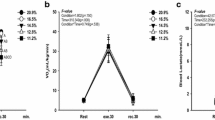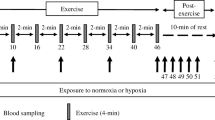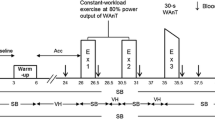Abstract
The present study examined the effect of hypoxia-induced respiratory alkalosis on exercise-induced metabolic acidosis and increases in plasma lactate and ammonia levels. Six male subjects underwent exercise of increasing intensity until exhaustion: (1) in normoxia (20.9% O2) (=MAX), (2) in hypoxia (12% O2) (=HP) in which hypoxic condition had been maintained from 60 min before to 30 min after exercise, and (3) the same intensity of exercise as HP in normoxia (=SUB). Arterialized blood was drawn from a superficial vein. Post-exercise blood pH was significantly higher in HP than in MAX (P<0.05), although plasma lactate was at the same level. For hypoxia as compared to normoxia, regression analysis confirmed a parallel shift of plasma lactate to higher pH levels indicating the effect of respiratory alkalosis (P<0.01). After exercise plasma levels of ammonia were lower in HP than in MAX (P<0.05). Regression analysis between ammonia and pH revealed nearly identical changes in hypoxia and normoxia at low pH. From these results, we conclude that: (1) hypoxia-induced respiratory alkalosis attenuated exhaustive exercise-induced metabolic acidosis, (2) plasma lactate concentration was determined by the relative exercise intensity, (3) the maximum plasma ammonia concentration under exhaustive exercise was reduced at hypoxia because of respiratory alkalosis.



Similar content being viewed by others
References
Bangsbo J, Juel C, Hellsten Y, Saltin B (1997) Dissociation between lactate and proton exchange in muscle during intense exercise in man. J Physiol (Lond) 504:489–499
Broberg S, Sahlin K (1989) Adenine nucleotide degradation in human skeletal muscle during prolonged exercise. J Appl Physiol 67:116–122
Brownlee KA (1965) Statistical theory and methodology in science and engineering. Wiley, New York
Casas H, Murtra B, Casas M, Ibáñez J, Ventura JL, Ricart A, Rodríguez F, Viscor G, Palacios L, Pagés T, Rama R (2001) Increased blood ammonia in hypoxia during exercise in humans. J Physiol Biochem 57:303–312
Davies SF, Iber C, Keene SA, McArthur CD, Path MJ (1986) Effect of respiratory alkalosis during exercise on blood lactate. J Appl Physiol 61:948–952
Dudley GA, Terjung RL (1985) Influence of acidosis on AMP deaminase activity contracting fast-twitch muscle. Am J Physiol 248:C43–C50
Forster HV, Dempsey JA, Thomson J, Vidruk E, DOPico GA (1972) Estimation of arterial PO2, PCO2, pH, and lactate from arterialized venous blood. J Appl Physiol 32:134–137
Hellsten Y, Richter EA, Kiens B, Bangsbo J (1999) AMP deamination and purine exchange in human skeletal muscle during and after intense exercise. J Physiol (Lond) 520:909–920
Hollidge-Horvat MG, Parolin ML, Wong D, Jones NL, Heigenhauser GJF (2000) Effect of induced metabolic alkalosis on human skeletal muscle metabolism during exercise. Am J Physiol 278:E316–E329
Jensen-Urstad M, Hallback I, Sahlin K (1995) Effect of hypoxia muscle oxygenation and metabolism during arm exercise in humans. Clin Physiol 15:27–37
Juel C (1998) Muscle pH regulation: role of training. Acta Physiol Scand 162:359–366
Lowenstein JM, Tornheim K (1971) Ammonia production in muscle: the purine nucleotide cycle. Science 171:397–400
Maston LG, Tran ZV (1993) Effects of sodium bicarbonate ingestion on aerobic performance: a meta-analytic review. Int J Sports Nutr 3:3–28
McLellan T, Jacobs I, Lewis W (1988) Acute altitude exposure and altered acid-base states.1. Effects on the exercise ventilation and blood lactate responses. Eur J Appl Physiol 57:435–444
Medbo JL, Hanem S, Noddeland H, Jebens E (2000) Arteriovenous differences of blood acid-base status and plasma sodium caused by intense bicycling. Acta Physiol Scand 168:311–326
Mutch BJC, Banister EW (1983) Ammonia metabolism in exercise and fatigue: a review. Med Sci Sports Exerc 15:41–50
Sahlin K, Broberg S (1990) Adenine nucleotide depletion in human muscle during exercise: causality and significance of AMP deamination. Int J Sports Med 11:S62–S67
Setlow B, Lowenstein JM (1967) Adenylate deaminase 2. Purification and some regulatory properties of the enzyme from calf brain. J Biol Chem 242:607–615
Sewell DA, Gleeson M, Blannin AK (1994) Hyperammonaemia in relation to high-intensity exercise duration in man. Eur J Appl Physiol 69:350–354
Spriet LL, Lindinger MI, Heigenhauser GJF, Jones NL (1986) Effects of alkalosis on skeletal muscle metabolism and performance during exercise. Am J Physiol 251:R833–R839
Sugden PH, Newsholme EA (1975) The effects of ammonium, inorganic phosphate and potassium ions on the activity of phosphofructokinases from muscle and nervous tissues of vertebrates and invertebrates. Biochem J 150:113–122
Taylor AD, Bronks R (1996) Effect of acute normobaric hypoxia on quadriceps integrated electromyogram and blood metabolites during incremental exercise to exhaustion. Eur J Appl Physiol 73:121–129
Yamauchi T, Matsui N (1996) Effect of blood pH on plasma ammonia and lactate concentrations during incremental exercise in men. Adv Exerc Sports Physiol 2:73–78
Young AJ (1990) Energy substrate utilization during exercise in extreme environments. Exerc Sport Sci Rev 18:65–117
Acknowledgements
We wish to thank all subjects who participated in this study for their cooperation. A portion of this research was supported by a grant from Chukyo University (Tokutei Kenkyu Josei) in 1999. The suggestions of Dr. E. Simon the Emeritus Professor at the W. G. Kerckhoff Institute, Max-Plank-Institute, Bad Nauheim, Germany, regarding the writing of our manuscript, are gratefully acknowledged.
Author information
Authors and Affiliations
Corresponding author
Additional information
An erratum to this article is available at http://dx.doi.org/10.1007/s00421-004-1102-9.
Rights and permissions
About this article
Cite this article
Kato, T., Matsumura, Y., Tsukanaka, A. et al. Effect of low oxygen inhalation on changes in blood pH, lactate, and ammonia due to exercise. Eur J Appl Physiol 91, 296–302 (2004). https://doi.org/10.1007/s00421-003-0975-3
Accepted:
Published:
Issue Date:
DOI: https://doi.org/10.1007/s00421-003-0975-3




